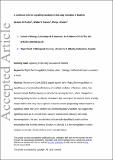A continued role for signalling functions in the early evolution of feathers
Abstract
Persons and Currie (2015) argued against either flight, thermoregulation, or signalling as a functional benefit driving the earliest evolution of feathers; rather, they favoured simple feathers having an initial tactile sensory function, which changed to a thermoregulatory function as density increased. Here, we explore the relative merits of early simple feathers that may have originated as tactile sensors progressing instead towards a signalling, rather than (or in addition to), a thermoregulatory function. We suggest that signalling could act in concert with a sensory function more naturally than could thermoregulation. As such, the dismissal of a possible signalling function and the presumption that an initial sensory function led directly to a thermoregulatory function (implicit in the title “bristles before down”) are premature.
Citation
Ruxton , G D , Persons IV , W S & Currie , P J 2017 , ' A continued role for signalling functions in the early evolution of feathers ' , Evolution , vol. 71 , no. 3 , pp. 797-799 . https://doi.org/10.1111/evo.13178
Publication
Evolution
Status
Peer reviewed
ISSN
1558-5646Type
Journal article
Collections
Items in the St Andrews Research Repository are protected by copyright, with all rights reserved, unless otherwise indicated.

